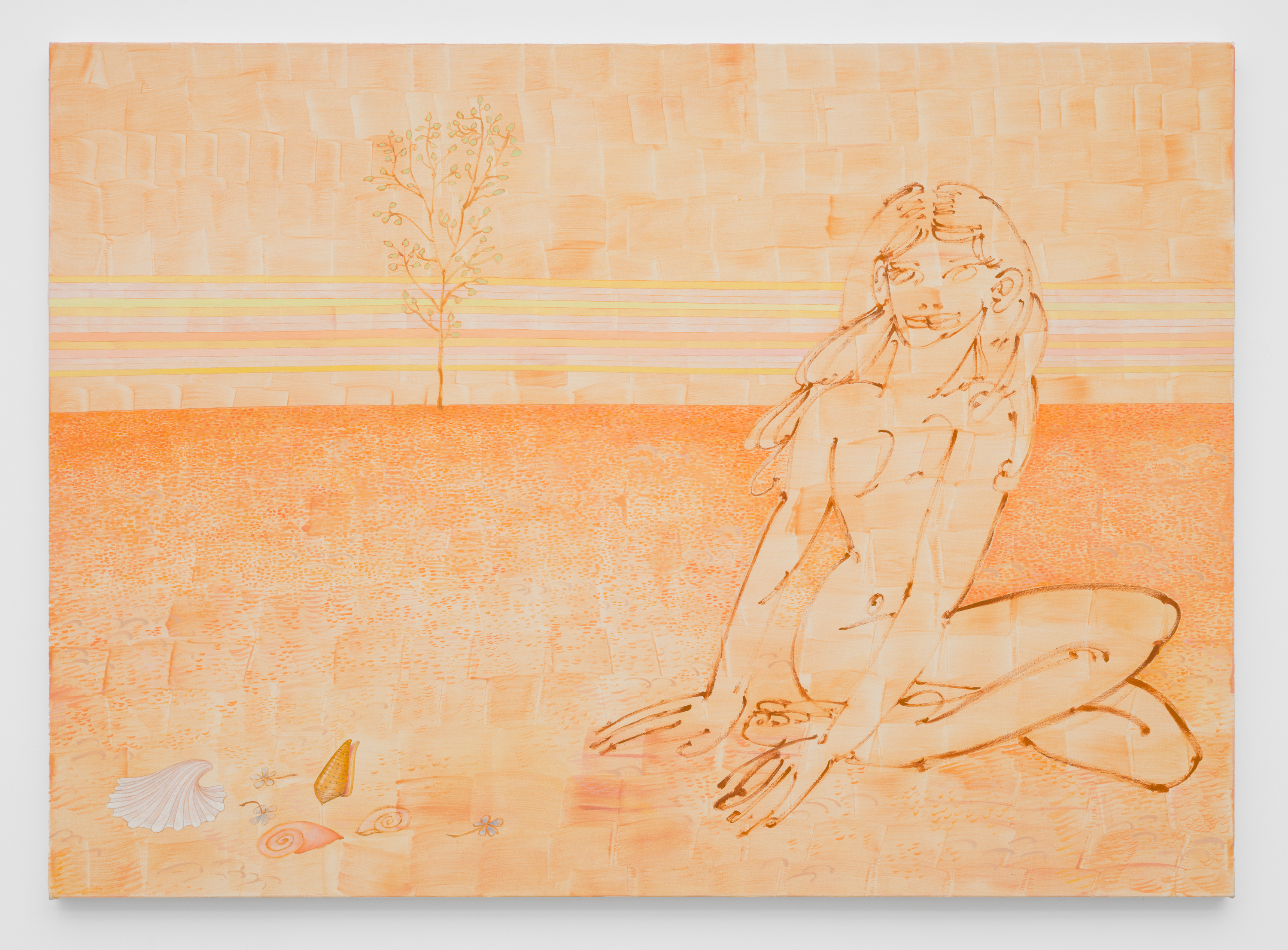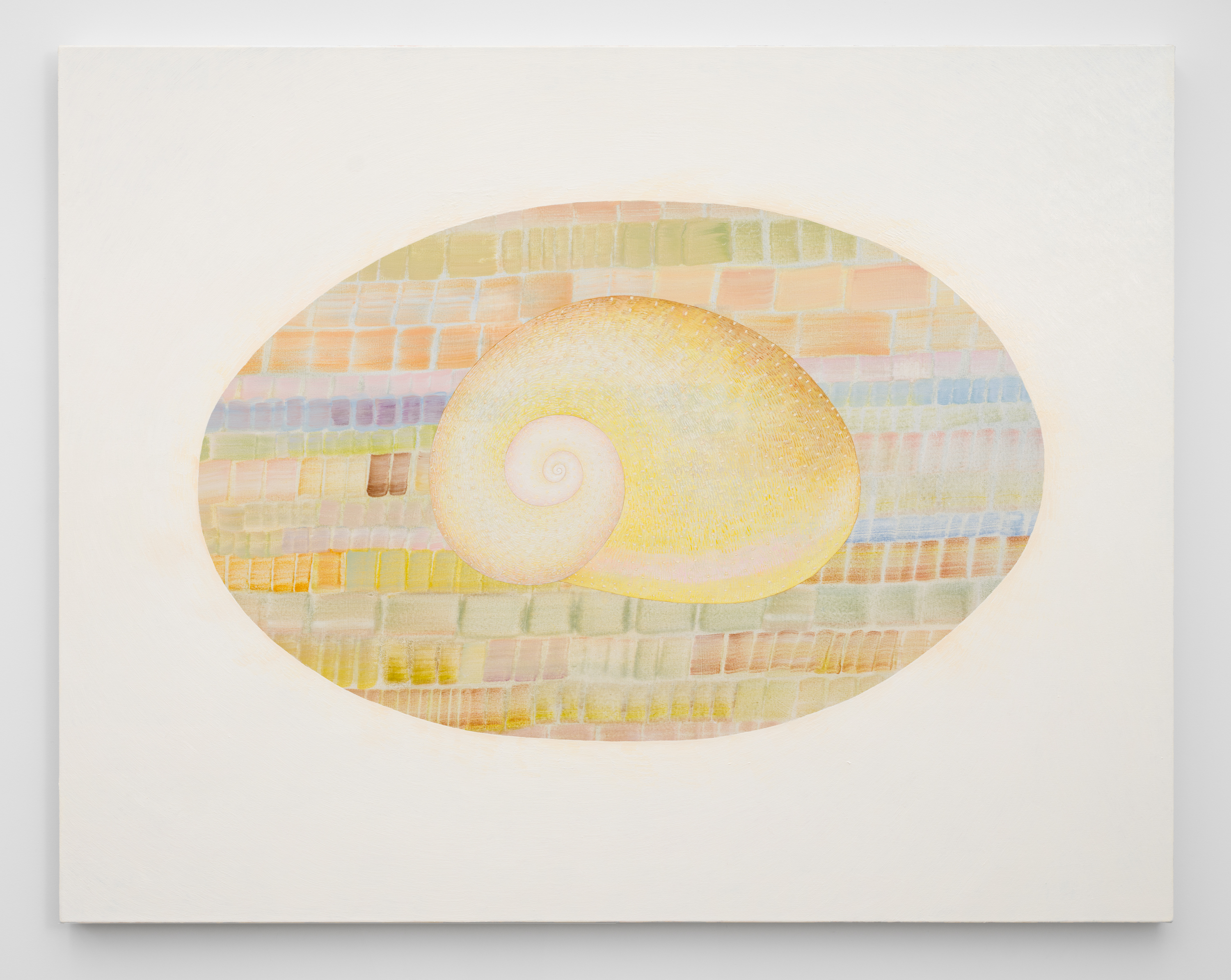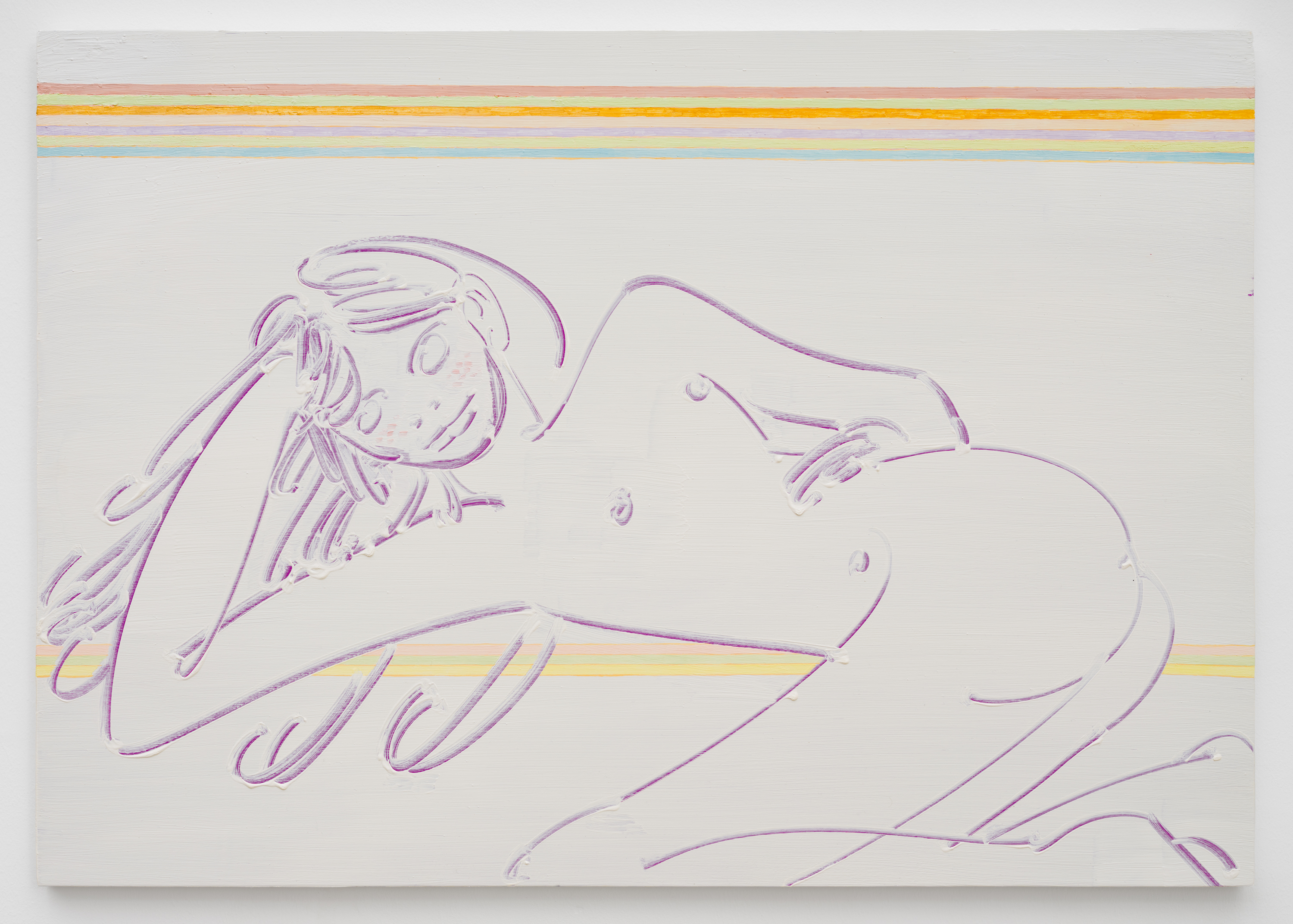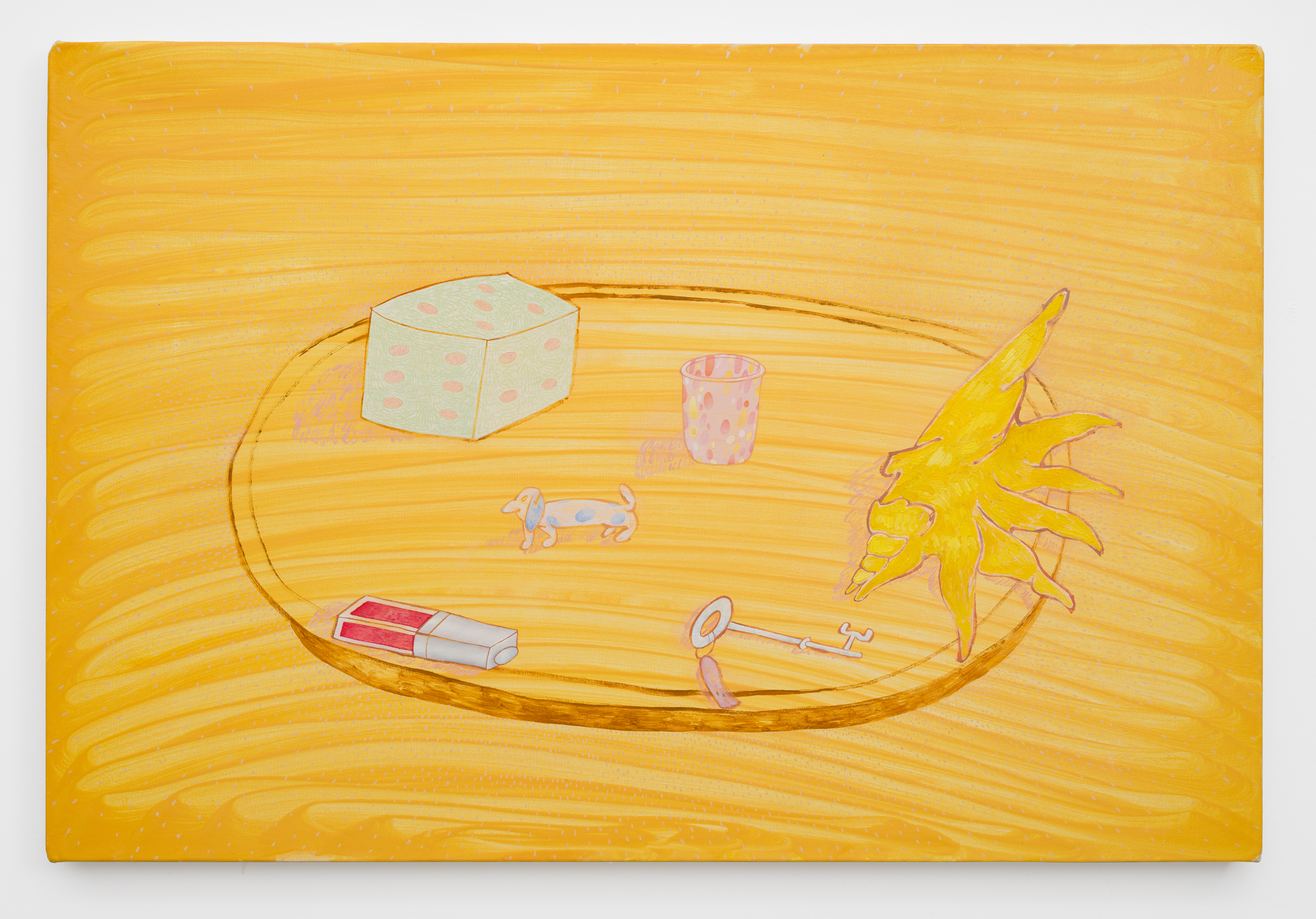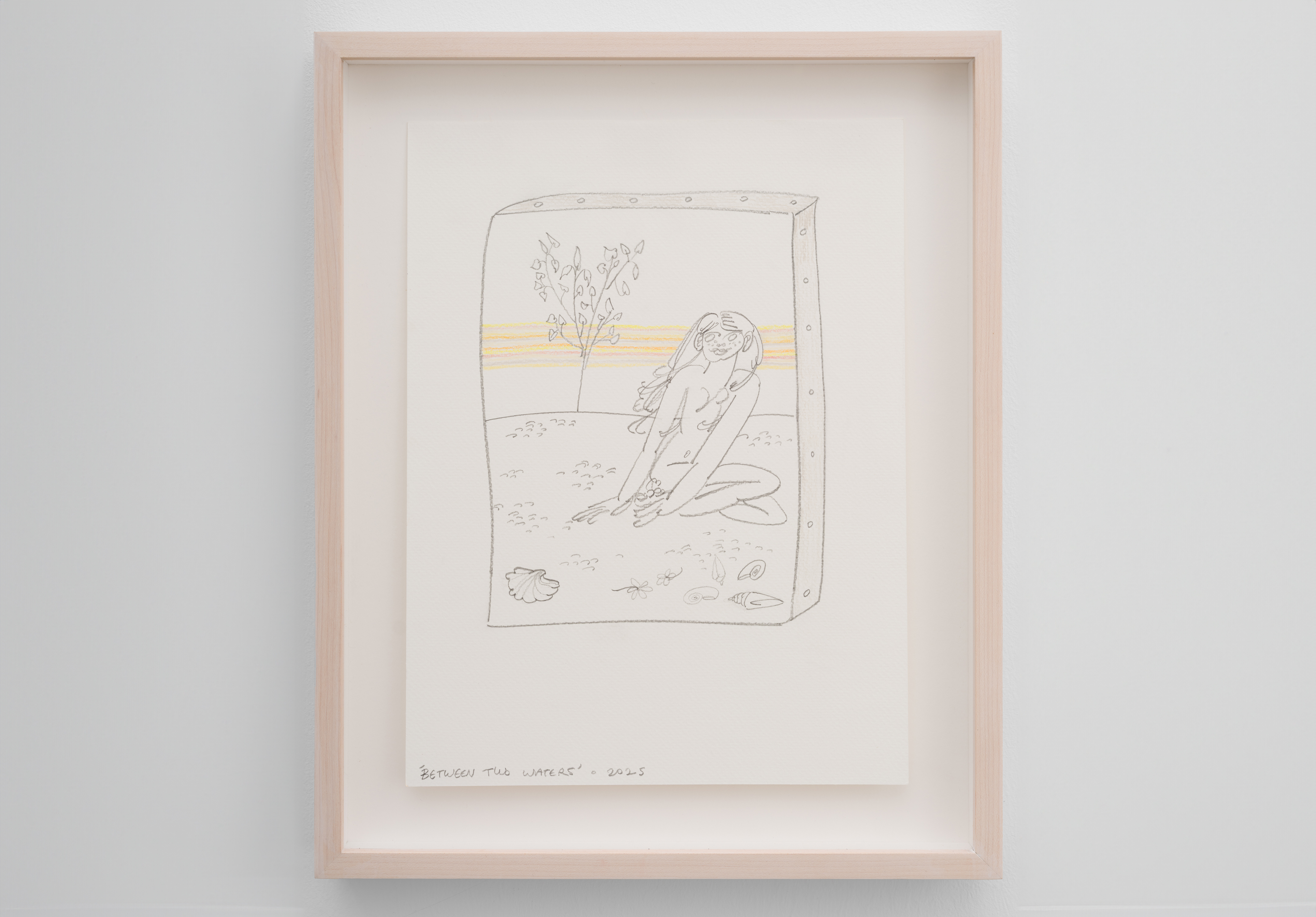Gal Schindler:
Between Two Waters


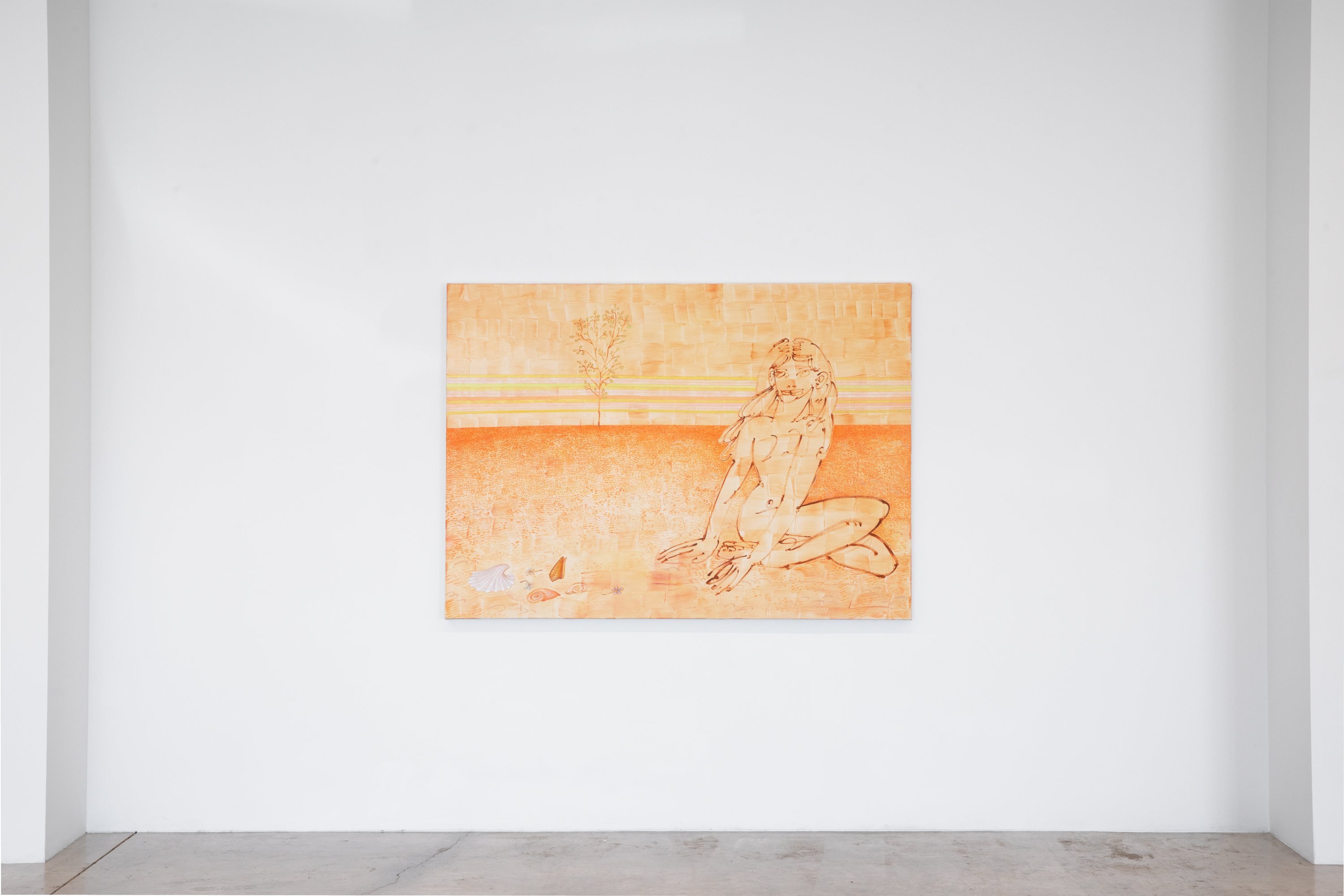
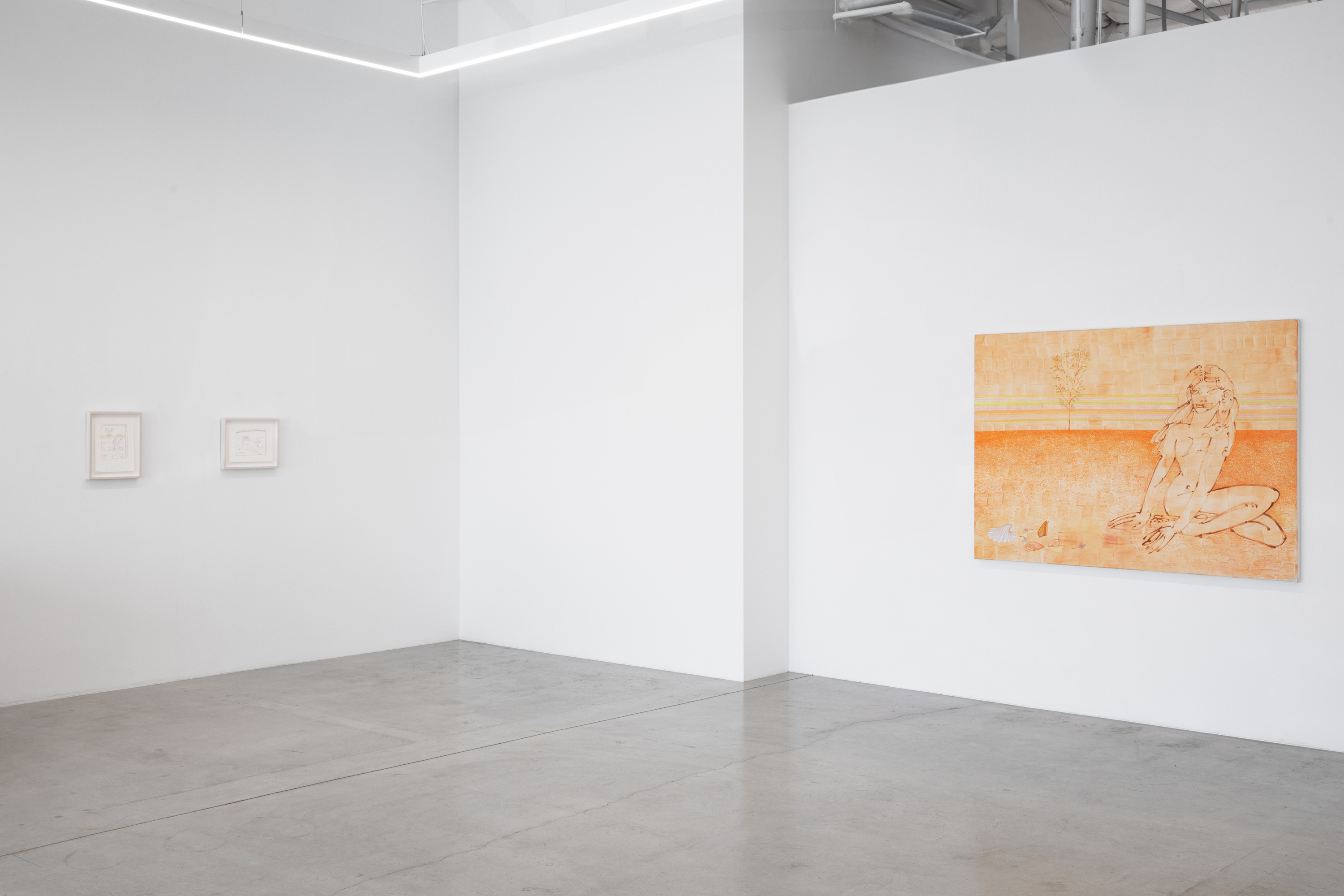


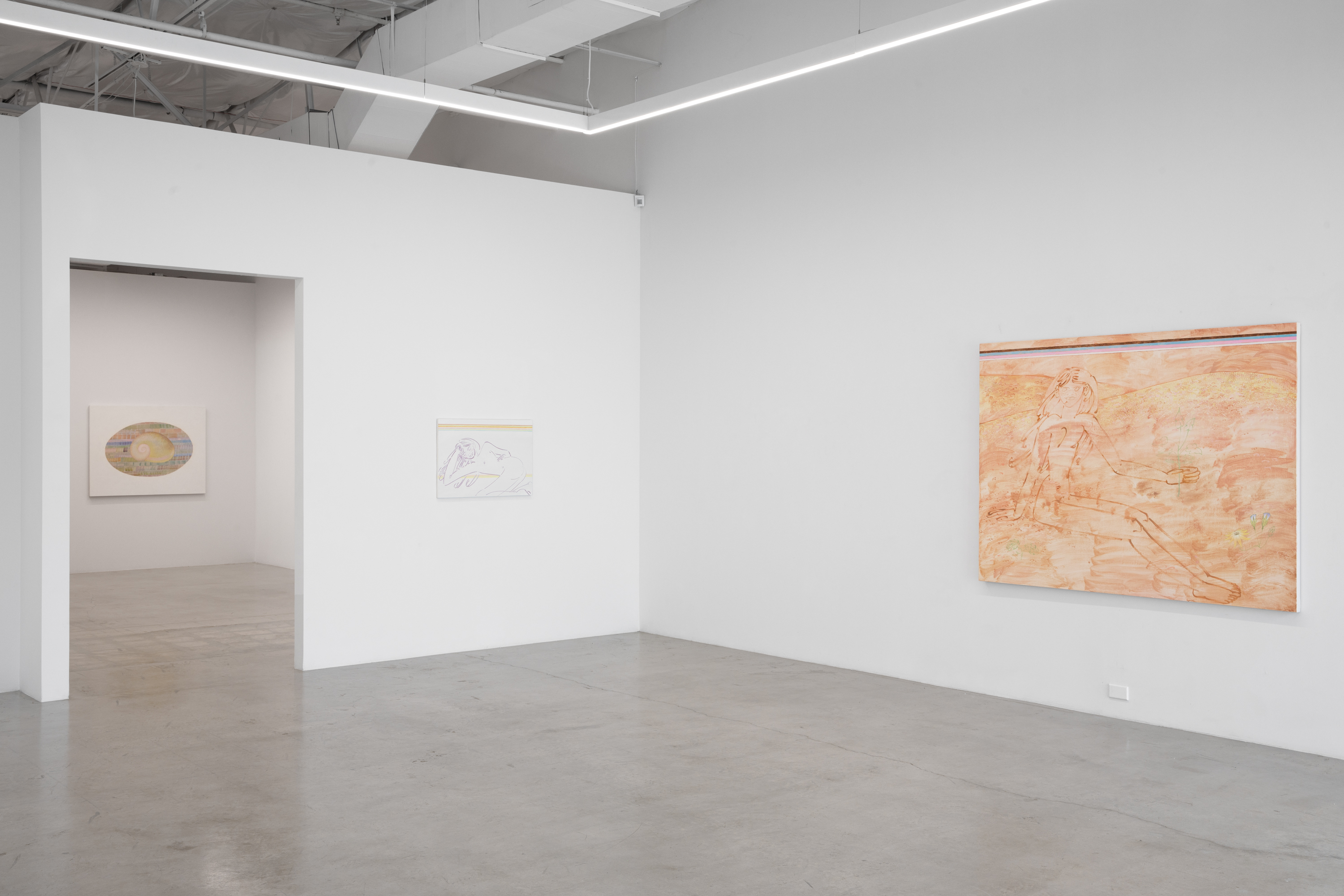
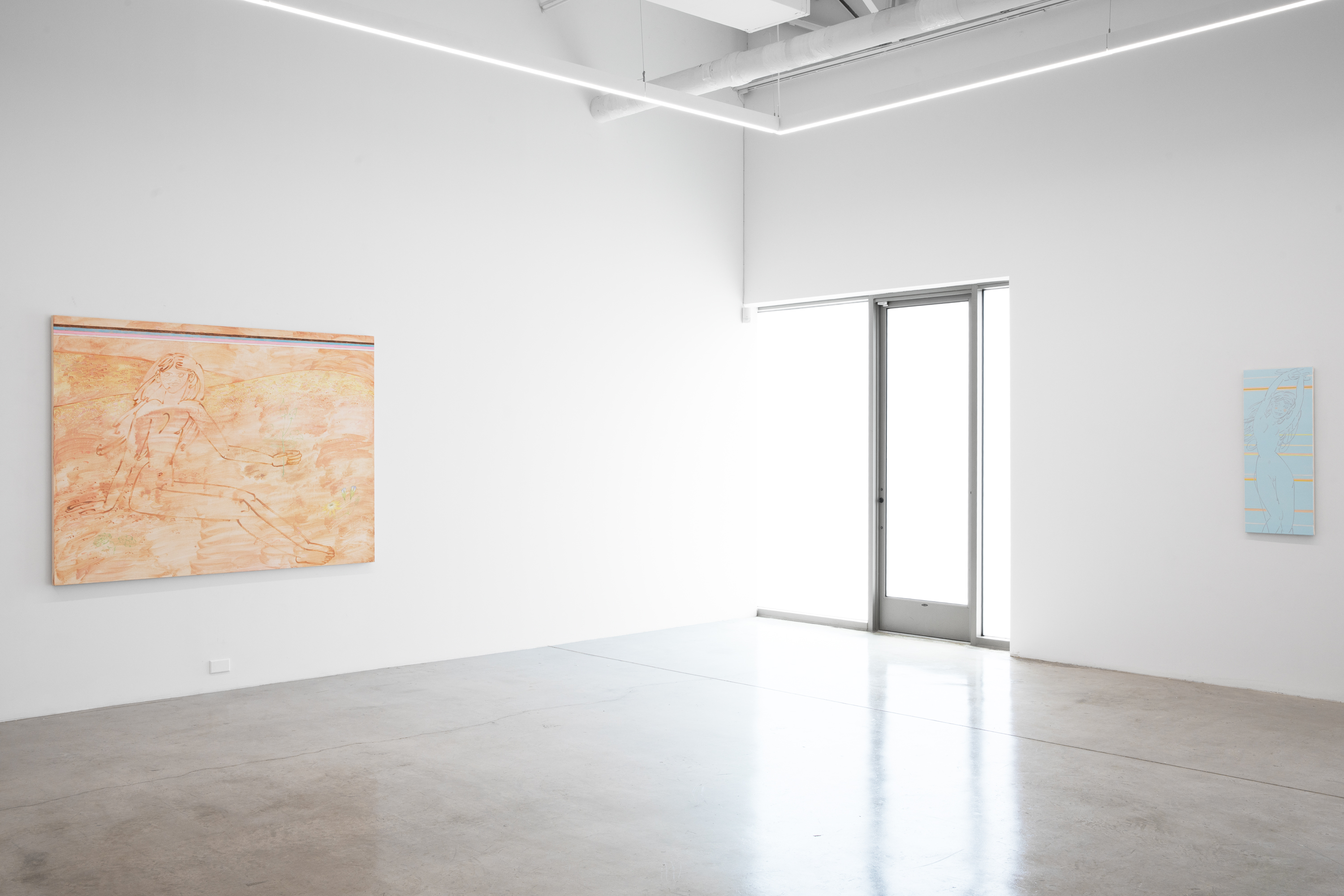
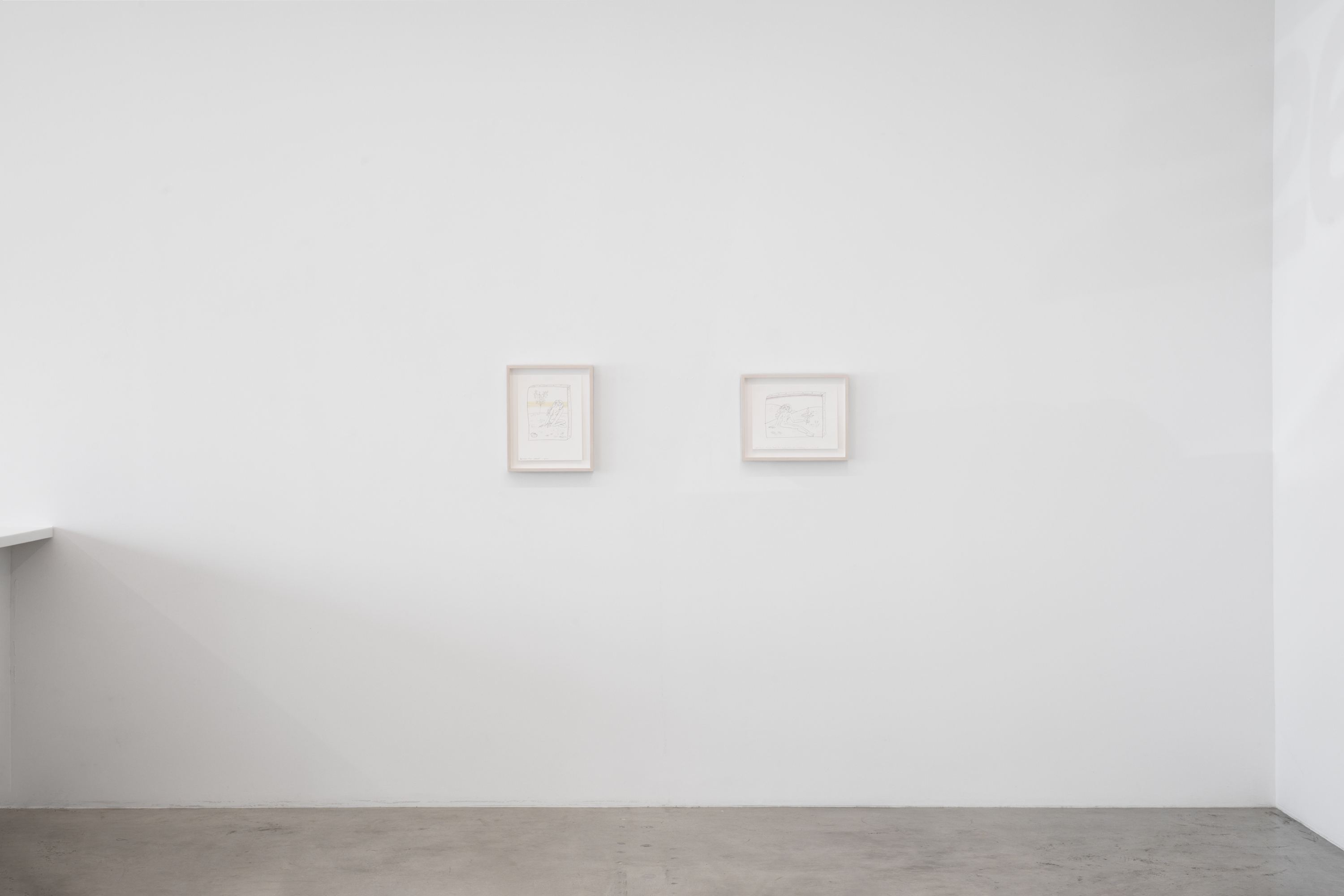

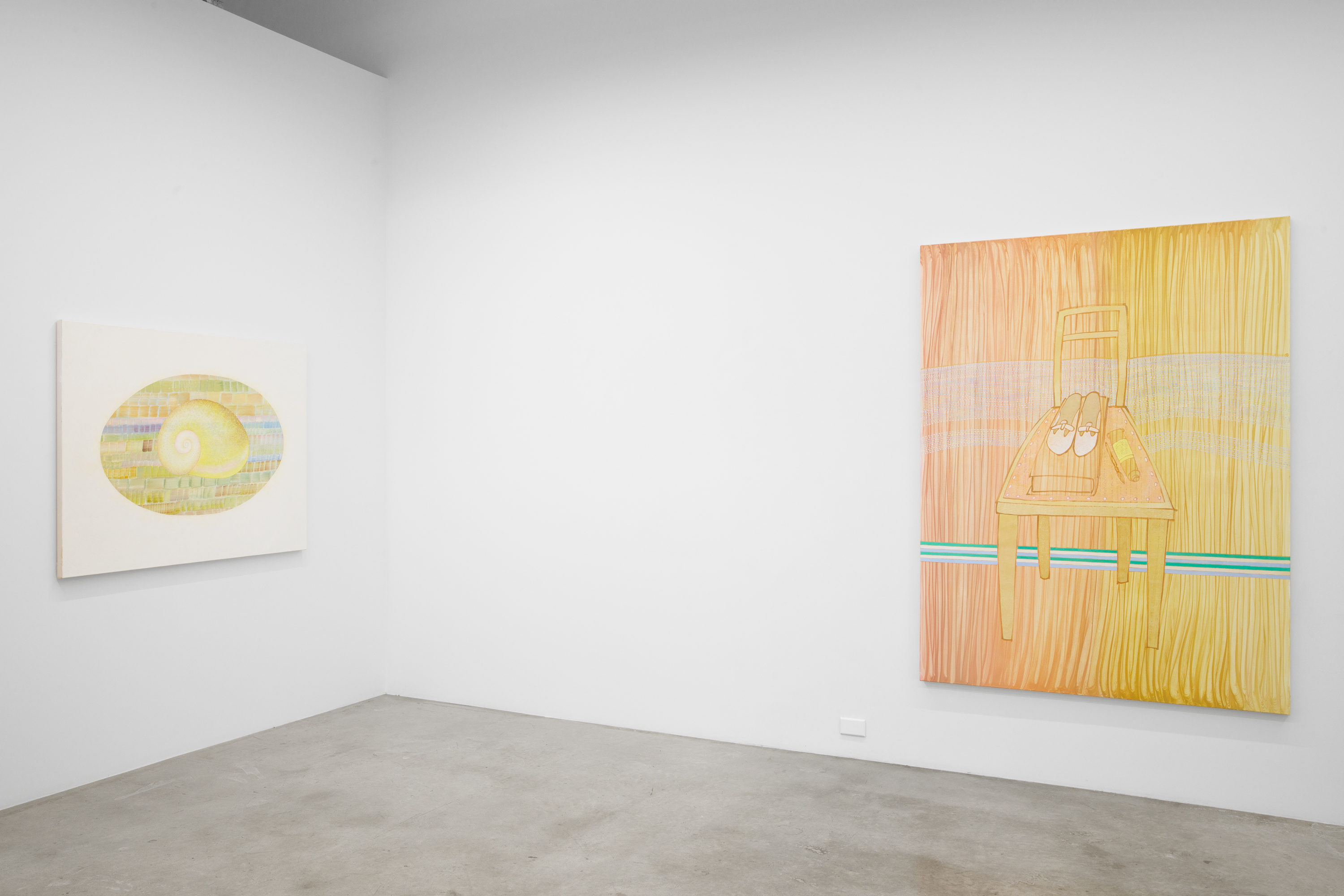

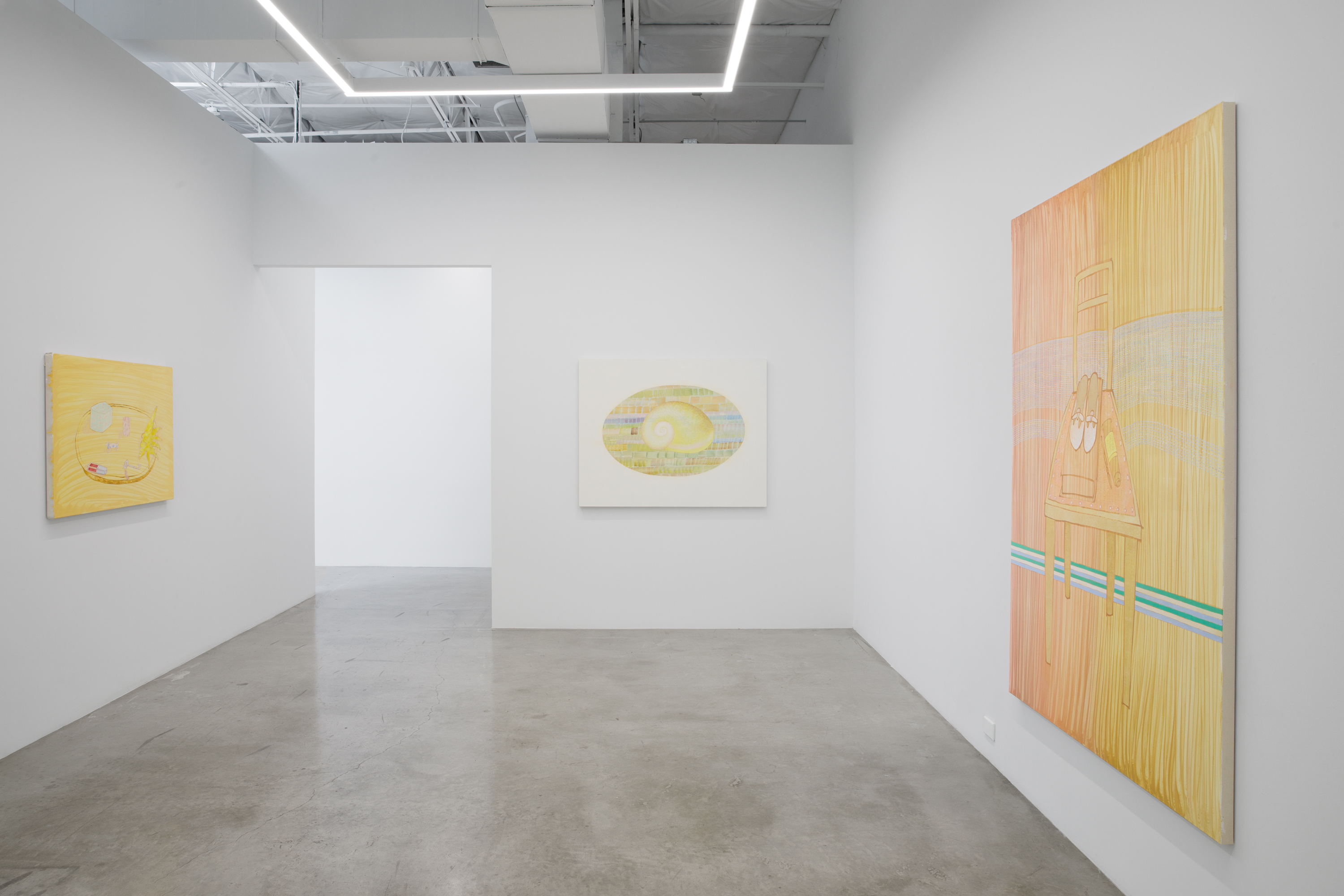
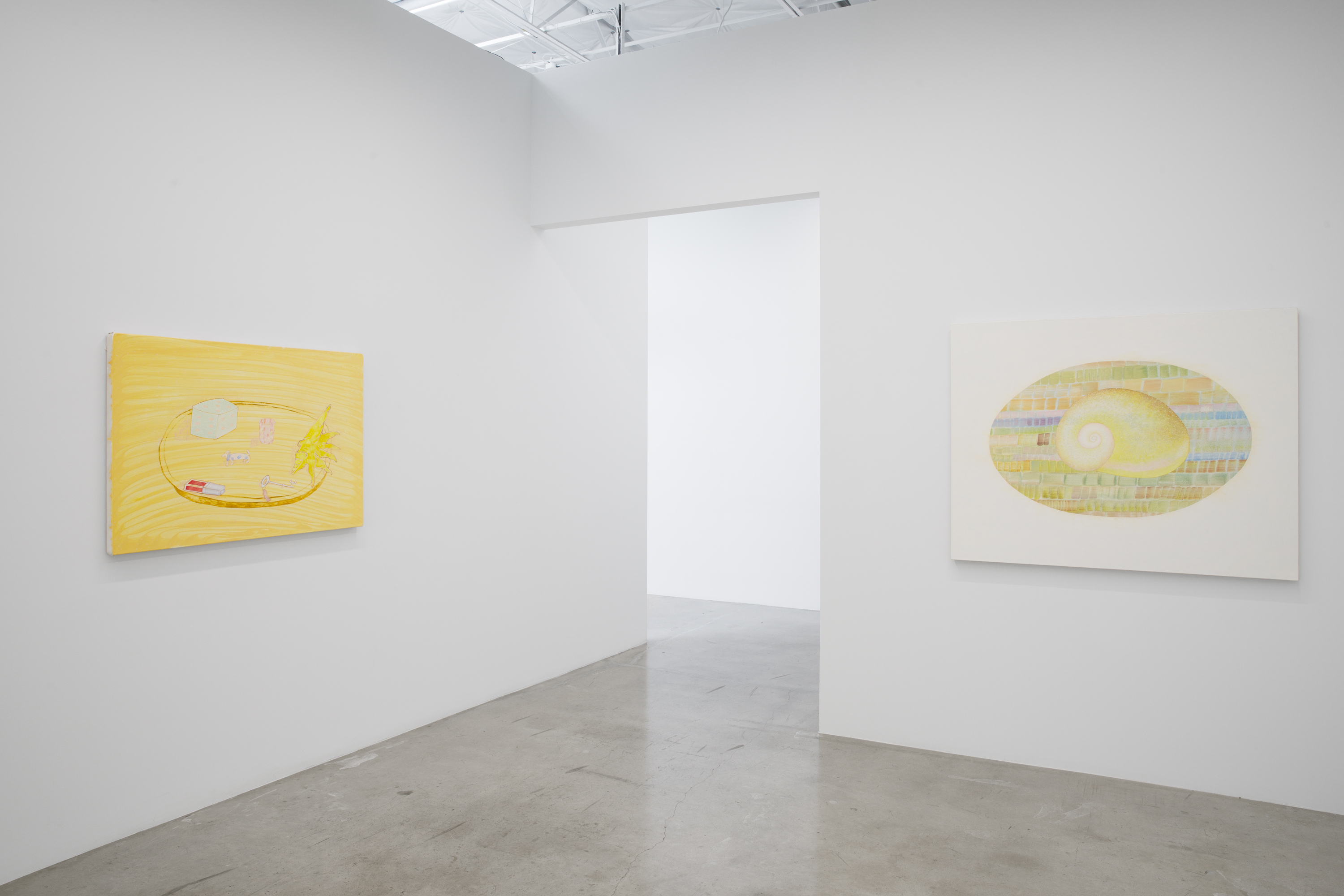

In Between Two Waters, Gal Schindler reminds us that beauty does not deny
chaos, but it exists alongside it.
The exhibition title draws inspiration from Entre dos Aguas (1976), a Spanish guitar composition by Paco de Lucía (1947–2014), a musician beloved by the artist’s mother. Although between two waters, the artist and her family remain spiritually intertwined beyond the distance that separates them. Enduring love, especially shared by women across time and space, is a recurrent theme in Schindler’s work. Although sharing physical attributes, each of her female figures possess a distinct essence that is entirely their own. In Schindler’s world, memory is not fixed but moves like water, carrying the emotional weight of those we love and the traces they leave behind.
Schindler evokes the Mediterranean in the warmth of her colour palette. With golden hues, yellows, whites, and pastels, her paintings can illuminate the darkest rooms. With the intention to holding on to beauty in times of uncertainty and collective grief, each work manifests a sense of healing and optimism. Indeed, Schindler’s paintings envelop the viewer with their calm, light-hearted presence, inviting the viewer to slow down and find comfort beyond the realm of contemporary life. Water runs through her practice as a constant presence, in both metaphor and matter. In psychoanalytic terms, the ocean also evokes the unknown as to many it is seen as vast and terrifying. Yet, it is also a source of peace, serenity and silence. This duality, explored by Schindler, is central to this new body of work. Furthermore, Schindler’s painted stripes recall the nautical, sailor's clothing, and the histories of those who live by or cross water. The poplar tree, with ‘heart shape’ leaves, is used as a symbol of resilience and tenderness, often growing near rivers and fresh waters.
Inspired by 16th and 17th century still lifes, the artist uses familiar objects of the everyday to portray grounding environments. In the sometimes disorienting landscape of London, a chair in her studio, a pair of shoes, a notebook, a shell... all become companions to navigate troubled waters. These paintings evoke a sense of acceptance towards things that seem at times uncontrollable or unanswerable, and meditate on what it means to be present. They stand as testaments of resilience and inner strength, suggesting that healing might begin in the simple little things of daily life.
One might also recognise Pierre Puvis de Chavannes’s Espérance (1871) in Schindler’s Hope (2025). A contemporary interpretation of the symbolist painting, Hope preserves the quiet solemnity and allegorical essence of de Chavannes’ original. Created in the aftermath of the Franco-Prussian War (1870) and the Paris Commune (1871), Espérance presents an allegory of resilience in the face of chaos. Schindler’s Hope offers a similar vision of optimism, as it responds to similarly turbulent times. A careful observer, Schindler has spoken of her ‘glass paintings’ and admiration for the painting’s thin, translucent layers, a formal quality she recreates in her own work. Through this lightness, she retains not only the aesthetic tone but also key poetic symbols from de Chavannes, notably the olive or oak branch. In Schindler’s version, the transparency of paint becomes a metaphor for vulnerability and clarity. Youth and
femininity emerge as quiet agents of resistance. Her work suggests that art can help us hold onto what is luminous and life affirming, without sinking into decay.
Text by Salomé Jacques.
---------------------------------
12.26 is pleased to present Between Two Waters, a solo exhibition of oil paintings by London-based artist Gal Schindler at the gallery’s Dallas location.
Between Two Waters presents works primarily of female figures, peaceful and reposed within subtle and subdued natural environments. It also includes still life and symbolic painted imagery evoking the objects and surroundings within Schindler’s personal life.
The painting Between Two Waters, echoing the exhibition’s title, shows a seated woman, legs crossed, naval and chest exposed, with long spindly phalanges, quaint pebble-like toes, and a face that appears refracted by the thick, broad, horizontal brushstrokes that cross her face and the entire surface of the canvas. Past the figure’s fingertips in the foreground lay various seashells and small floral sprigs. In the distant background, against the horizon line, resides a single isolated poplar tree with its thin trunk and branches populated with green leaves. Poplars, which grow near flowing bodies of water, symbolically reflect hope, resilience, and new beginnings.
Similar in composition is Untitled (After ‘Hope’ by Pierre Puvis de Chavannes), yet this figure is more open, seated amongst flowers and swelling hills, she grasps the branch of an oak tree and delicately extends it to the viewer. These brushstrokes suggest a different movement, perhaps reflecting an internal nuance to Schindler and her body of work. A band of brown, blue, pink, and white appears at the top of the canvas, a frequent and identifiable mark of Schindler’s work.
The ocean plays an essential role in Between Two Waters as the site for Schindler’s subjects and the symbolic carrier of meaning. In Shell 1 and 2, the artist detaches the banded and conus shells from their natural environment; neither rests on sand but rather an abstracted, tile-like background of color. Schindler has been studying shells for their formal and symbolic qualities, appreciating their dialogue with timelessness, introspection, and femininity.
Studio Chair and Autumn Table represent a transition in Schindler’s work to still life compositions. The chair, which has been in the artist’s life for many years, holds a book, a pair of white flats, a singular paint tube, and a paintbrush. The plate contains pale green dice, a tube of currant-colored Dior lipstick, a key, a miniature elongated polka dot wiener dog, a pinkish speckled glass vessel, and a large seashell. Both paintings act as self-portraits, identifying Schindler's state of mind as an artist and the items and objects that accompany her being.
Gal Schindler (b. 1993, Tel Aviv) lives and works in London, UK. Schindler graduated from the Slade School of Fine Art in 2019 and received her MA from the Royal College of Art in London in 2021. Schindler has presented solo exhibitions with Ginny on Frederick, London, UK (2024 & 2022); Galerie Sultana, Paris, FR (2023); James Fuentes, New York, NY (2022); and Painters Painting Paintings, UK. Schindler has exhibited in numerous group exhibitions, including Galerie Sultana, Paris, FR (2024); Tube Culture Hall, Milan, IT (2024); Dans les yeux d’Elsa, Paris, FR (2024); The Approach, London, UK (2024); Ginny on Frederick, London UK (2024); Linseed Projects, Shanghai, CN (2023); Sultana Summer Set, Arles, FR (2023); Braverman gallery (2023); The Perimeter collection, London (2022) ; Sapling, London, UK (2022); the Artist Room Gallery, Seoul, KR (2022); Daulang Gallery, Seoul, KR (2022); MAMOTH Gallery, London, UK (2020); among others.
The exhibition title draws inspiration from Entre dos Aguas (1976), a Spanish guitar composition by Paco de Lucía (1947–2014), a musician beloved by the artist’s mother. Although between two waters, the artist and her family remain spiritually intertwined beyond the distance that separates them. Enduring love, especially shared by women across time and space, is a recurrent theme in Schindler’s work. Although sharing physical attributes, each of her female figures possess a distinct essence that is entirely their own. In Schindler’s world, memory is not fixed but moves like water, carrying the emotional weight of those we love and the traces they leave behind.
Schindler evokes the Mediterranean in the warmth of her colour palette. With golden hues, yellows, whites, and pastels, her paintings can illuminate the darkest rooms. With the intention to holding on to beauty in times of uncertainty and collective grief, each work manifests a sense of healing and optimism. Indeed, Schindler’s paintings envelop the viewer with their calm, light-hearted presence, inviting the viewer to slow down and find comfort beyond the realm of contemporary life. Water runs through her practice as a constant presence, in both metaphor and matter. In psychoanalytic terms, the ocean also evokes the unknown as to many it is seen as vast and terrifying. Yet, it is also a source of peace, serenity and silence. This duality, explored by Schindler, is central to this new body of work. Furthermore, Schindler’s painted stripes recall the nautical, sailor's clothing, and the histories of those who live by or cross water. The poplar tree, with ‘heart shape’ leaves, is used as a symbol of resilience and tenderness, often growing near rivers and fresh waters.
Inspired by 16th and 17th century still lifes, the artist uses familiar objects of the everyday to portray grounding environments. In the sometimes disorienting landscape of London, a chair in her studio, a pair of shoes, a notebook, a shell... all become companions to navigate troubled waters. These paintings evoke a sense of acceptance towards things that seem at times uncontrollable or unanswerable, and meditate on what it means to be present. They stand as testaments of resilience and inner strength, suggesting that healing might begin in the simple little things of daily life.
One might also recognise Pierre Puvis de Chavannes’s Espérance (1871) in Schindler’s Hope (2025). A contemporary interpretation of the symbolist painting, Hope preserves the quiet solemnity and allegorical essence of de Chavannes’ original. Created in the aftermath of the Franco-Prussian War (1870) and the Paris Commune (1871), Espérance presents an allegory of resilience in the face of chaos. Schindler’s Hope offers a similar vision of optimism, as it responds to similarly turbulent times. A careful observer, Schindler has spoken of her ‘glass paintings’ and admiration for the painting’s thin, translucent layers, a formal quality she recreates in her own work. Through this lightness, she retains not only the aesthetic tone but also key poetic symbols from de Chavannes, notably the olive or oak branch. In Schindler’s version, the transparency of paint becomes a metaphor for vulnerability and clarity. Youth and
femininity emerge as quiet agents of resistance. Her work suggests that art can help us hold onto what is luminous and life affirming, without sinking into decay.
Text by Salomé Jacques.
---------------------------------
12.26 is pleased to present Between Two Waters, a solo exhibition of oil paintings by London-based artist Gal Schindler at the gallery’s Dallas location.
Between Two Waters presents works primarily of female figures, peaceful and reposed within subtle and subdued natural environments. It also includes still life and symbolic painted imagery evoking the objects and surroundings within Schindler’s personal life.
The painting Between Two Waters, echoing the exhibition’s title, shows a seated woman, legs crossed, naval and chest exposed, with long spindly phalanges, quaint pebble-like toes, and a face that appears refracted by the thick, broad, horizontal brushstrokes that cross her face and the entire surface of the canvas. Past the figure’s fingertips in the foreground lay various seashells and small floral sprigs. In the distant background, against the horizon line, resides a single isolated poplar tree with its thin trunk and branches populated with green leaves. Poplars, which grow near flowing bodies of water, symbolically reflect hope, resilience, and new beginnings.
Similar in composition is Untitled (After ‘Hope’ by Pierre Puvis de Chavannes), yet this figure is more open, seated amongst flowers and swelling hills, she grasps the branch of an oak tree and delicately extends it to the viewer. These brushstrokes suggest a different movement, perhaps reflecting an internal nuance to Schindler and her body of work. A band of brown, blue, pink, and white appears at the top of the canvas, a frequent and identifiable mark of Schindler’s work.
The ocean plays an essential role in Between Two Waters as the site for Schindler’s subjects and the symbolic carrier of meaning. In Shell 1 and 2, the artist detaches the banded and conus shells from their natural environment; neither rests on sand but rather an abstracted, tile-like background of color. Schindler has been studying shells for their formal and symbolic qualities, appreciating their dialogue with timelessness, introspection, and femininity.
Studio Chair and Autumn Table represent a transition in Schindler’s work to still life compositions. The chair, which has been in the artist’s life for many years, holds a book, a pair of white flats, a singular paint tube, and a paintbrush. The plate contains pale green dice, a tube of currant-colored Dior lipstick, a key, a miniature elongated polka dot wiener dog, a pinkish speckled glass vessel, and a large seashell. Both paintings act as self-portraits, identifying Schindler's state of mind as an artist and the items and objects that accompany her being.
Gal Schindler (b. 1993, Tel Aviv) lives and works in London, UK. Schindler graduated from the Slade School of Fine Art in 2019 and received her MA from the Royal College of Art in London in 2021. Schindler has presented solo exhibitions with Ginny on Frederick, London, UK (2024 & 2022); Galerie Sultana, Paris, FR (2023); James Fuentes, New York, NY (2022); and Painters Painting Paintings, UK. Schindler has exhibited in numerous group exhibitions, including Galerie Sultana, Paris, FR (2024); Tube Culture Hall, Milan, IT (2024); Dans les yeux d’Elsa, Paris, FR (2024); The Approach, London, UK (2024); Ginny on Frederick, London UK (2024); Linseed Projects, Shanghai, CN (2023); Sultana Summer Set, Arles, FR (2023); Braverman gallery (2023); The Perimeter collection, London (2022) ; Sapling, London, UK (2022); the Artist Room Gallery, Seoul, KR (2022); Daulang Gallery, Seoul, KR (2022); MAMOTH Gallery, London, UK (2020); among others.
